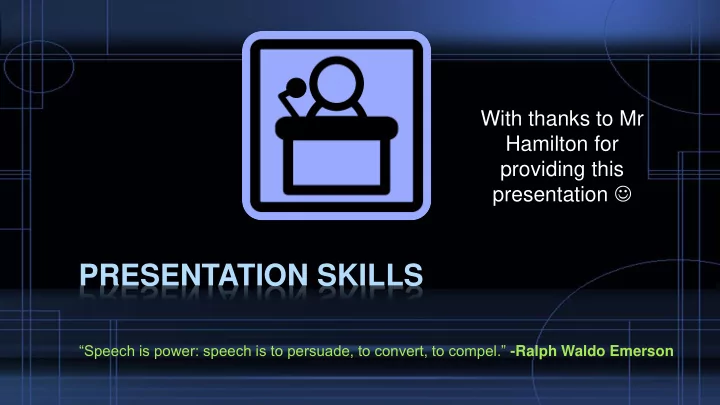

With thanks to Mr Hamilton for providing this presentation PRESENTATION SKILLS “Speech is power: speech is to persuade, to convert, to compel.” -Ralph Waldo Emerson
Paired Discussion With your partner, rank the top three “do nots” for a successful presentation
Spoiler Alert! In this lesson, we will discuss and discover: Why it is important to deliver interesting and successful presentations How to effectively prepare your presentation What to do in order to deliver your presentation in an engaging way
Why bother? – Presenting in the Workplace Question: What jobs require presentation skills? Answer: Every job! From McDonalds to Microsoft, employees are expected to speak confidently and present themselves in an engaging manner. A recent study found that 70% of American employees think that good presentation skills is critical to their success at work. Why is this?
Why bother? – Presenting in Education In school, presentation skills are assessed in a variety of different subjects and seen as an important part of literacy In many university and college course, student-led presentations form a mandatory part of your grades It’s time to become supreme speakers!
Preparing to Present – Worth the effort! “ It usually takes me more than three weeks to prepare a good impromptu speech.” – Mark Twain Completely off the cuff presentations rarely work, and are easy to spot! If you prepare thoroughly, your presentation will have more impact on the audience and (most importantly) reduce stress for you!
Preparing to present – Choosing a topic Your topic should be: Relevant – Make sure what you are saying relates to the task you have been given! Original – Saying something fresh and new is exciting; treading the same old ground isn’t… Interesting – Your topic should hold the interest of your audience, so consider what they might like to hear. Suitably sized – Anything too big or complex can’t be addressed in the time you have, and anything too small or simple will become dragged out and boring!
Preparing a presentation – Researching Before, you can write anything down, you must know about your topic! Make sure that all your research is taken from respected sources (i.e. not Wikipedia or the Beano ) to make sure that it is correct. Only include information that is necessary to your topic. Don’t just read a list of facts! You may need to answer questions, so make sure you know your topic well.
Preparing a presentation – putting pen to paper When writing your presentation, make sure it follows a clear structure: Beginning – grab your audience’s attention with an impactful or humorous anecdote. Middle – largest part which covers your argument or information. End – Summary of key points. Aim to finish with a flourish: powerful final statement, humour, or a question for audience to consider. These should all be written as notes , and not as an essay to be read!
Preparing a Presentation You should always PRACTISE before delivery! Use your phone to record you speaking. This allows you to hear what needs tweaking or more practice. Time yourself to make sure that you are within expected time constraints.
Delivery is as important as content! Speak clearly and loudly - Don’t need to shout, but make sure that you are heard and not speaking too fast to be understood. Show your passion - If you’re not interested in your topic, why should your audience be? Sound natural – Don’t sound like you are reading, or have memorised a script. This is why note prompts are important. Positive body language – Be animated! Take hands out of pockets and use them to stress a point, to list on your fingers or widen your arms for emphasis. –
A note on visual aids Posters, pictures and PowerPoints can add an engaging visual aspect. BUT: Most speeches only need one visual which does not dominate. Use them sparingly, and NEVER just read from them.
It really works! Watch the following clip and use what you have learnt in this lesson to identify and note down the strengths of his presentation
Ken Robinson: Do schools kill creativity?
Share with your partner notes on the TED talk.
Recommend
More recommend